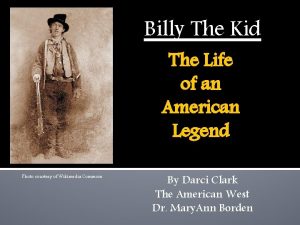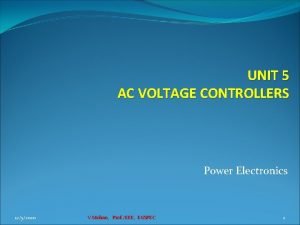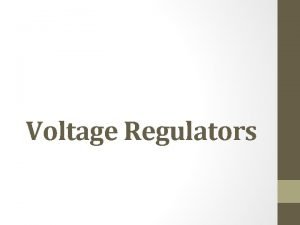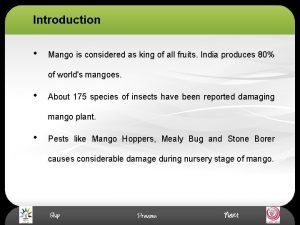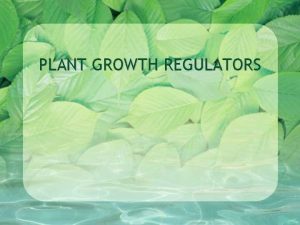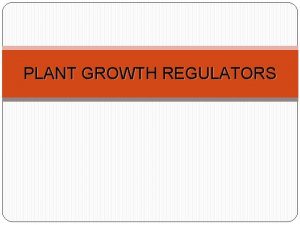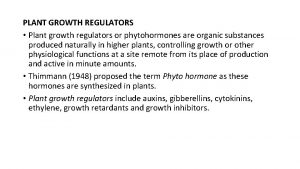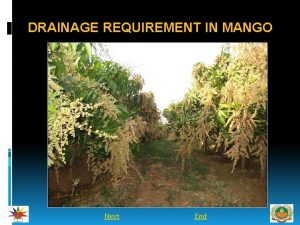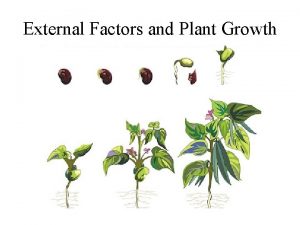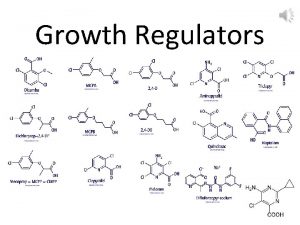PLANT GROWTH REGULATORS IN MANGO Next End INTRODUCTION
















- Slides: 16

PLANT GROWTH REGULATORS IN MANGO Next End

INTRODUCTION • Plant growth regulators are organic substances which are produced in a one part of plant and it translocate to other parts of plant. • It also available in synthetic form. Previous Next End

MANGO MALFORMATION Different methods of checking malformation like pruning of diseased portions, use of fungicides, plant growth regulators and de blossoming have been tried with some success. To control this malady, the affected shoots should be removed every month and destroyed. One spray of 200 ppm NAA in October (dissolve 110 g NAA in some alcohol and make up to 550 litre) is effective in reducing the incidence of malformation. Spray of NAA (100 to 200 ppm) during the first week of October has been worked out to reduce floral malformation. Previous Next End

CONT. . • Later, four sprays of 250 ppm NAA at weekly intervals from 20 th October onwards have been suggested to reduce the intensity of malformation to the maximum possible. • Hence spray of 100 ppm NAA has been suggested instead of 200 ppm NAA. • Also observed that spraying 200 ppm NAA in first week of October followed by spraying of 500 ppm of ethrel at bud inception stage during February was highly effective in reducing floral malformation. • Spray of 400 ppm of Ethephon at bud inception stage reduced the floral malformation significantly. Previous Next End

CONT. • Increase in floral branches and yield was observed by the spraying of ethrel (250 or 500 ppm) or uniconazole 500 ppm in the month of December. • The gibberellic acid at 50 ppm causes delayed panicle emergence, increased number of perfect flowers and increased pollen viability. • Sprays in the months of October and November cause 50% reduction in malformation. Previous Next End

FRUIT DROP • Fruit drop may be controlled to some extent by the spray of 20 ppm of 2, 4 -D (2 g in 100 litres of water) in the last week of April or in the first week of May in Langra and Dusehari cultivars. • Post harvest treatment with GA 3 at 200 ppm has been found highly effective in retarding ripening of Mallika, Alphonso and Kesar mangoes. • GA 3 treatment retarded the total loss in weight, chlorophyll and ascorbic acid content and reduced amylase and peroxidase activity during ripening. Previous Next End

CONT. • Similarly pre harvest application of GA 3 also influenced the post harvest ripening behavior of mango. • Embryo abortion, climatic factors , disturbed water relation, lack of nutrition, attack of disease and pest, hormonal imbalances are the major factors that lead to fruit drop. • A spray of Alar (B-Nine) @ 100 ppm or 20 ppm 2, 4 -D (2 g. in 100 l. water) in the last week of April or in the last week of May will control to some extent the summer fruit drop in Langra & Dashehari. Previous Next End

CONT. • Application of plant growth substances like NAA@ 25 ppm or 2, 4 -D @ 10 -15 ppm during pea stage of fruit are helpful in reducing fruit drop. • Studies on the use of plant growth substances for fruit retention in mango cv. Dashehri were conducted at pant nagar. Growth regulators were applied at 3 different stage to 12 year old trees. NAA@ 40 ppm gave the best fruit retention when applied at the pre bloom stage. At the pea stage CCC @ 200 ppm gave the best results and the marble stage Ag. No 3 @ 200 ppm gave the best results. Previous Next End

CONT. • 2, 4 -D (30 ppm) has given good results in controlling fruit drop in var. Neelum, without having any adverse effect on fruit size or TSS. • Flower and fruit drop is a problem in many fruit crops. Application of NAA 10 - 50 ppm in mango reduce fruit drop by preventing formation of abscission layer. • Early Ripening and Colour Development, Fruits like mango, banana, papaya ripes after harvest. • Dipping of fruits in 20 -50 ppm Ethrel solution induces golden yellow colour to fruit induces early maturity. Previous Next End

CONT. • NAA @ 20 ppm is sprayed at flowering to increase the fruit retention. • During February 0. 5% Urea (5 g/lit. ) or 1% Potassium Nitrate (10 g/lit. ) may be sprayed to induce flowering, if trees do not flower by that time. • Spraying of 2% KNO 3 at mustard size will increase the fruit set and retention of fruits. Previous Next End

ALTERNATE BEARING • To control alternate bearing using an ethylene releasing compound, ethepon inducing flowers several year. • In mango, application of ethepon 200 ppm coupled with 0. 1 per cent urea was found effective in inducing regular flowering over the year. • Five sprays all recommended to be made beginning from middle of September at monthly interval. • Proper cultural practices like addition of fertilizers and control of diseases and insect pests may be adopted to regulate growth and bearing Previous Next End

• Regular bearing varieties viz. Dashehari and Amrapalli may be grown. Deblossoming of the panicles with NAA @ 200 ppm. (20 g. /100 l. water) during ‘on’ year may help to regulate the bearing. Application of paclobutrazol • Growth retardant called ‘Paclobutrazol’ is used to induce flowering in mango. • Application of Paclobutrazol @ 10 g a. i. for non-bearing trees during first fortnight of September will induce flowering and fruitset yield during off years Previous Next End

APPLICATION OF PACLOBUTRAZOL • Spraying of 1000 ppm Paclobutrazol (10 -60 gm/tree), prior to FBD, during the first week of October reduced malformation, increased number of healthy flowers and increased the yield. Previous Next End

PARTHENOARPY • Induce parthenocarpy through the application of NAA@ 10 ppm at anthesis followed by a combination of NAA @ 10 ppm & GA 3 @ 250 ppm at fortnightly intervals. Such fruit could not attain normal size rather remained smaller in size, but were superior in taste as compared to normal seeded fruit. • Natural parthenocarpy is not reported to occur in mango. However, exogenous applications of N 6 – Banzyladenine (250 ppm) at fortnightly intervals, resulted in the production of seedless fruits in Dashehiri Previous Next End

SMUDGING • Induction of flowering in mango through smudging is an age old practice in the Philippines. • Some attribute the flowering to heat whereas the others hold CO 2 responsible for this. However, these have not been found to be helpful in India. • In recent years, Ethrel has also been tried to induce flowering in mango during the off year and some success has also been claimed in this regard. Previous Next End

RIPENING • Fully developed green Langra and Dusehari mangoes can be artificially ripened by treating with 800 ppm @ 1. 5 g/kg of fruit. The time for ripening reduces to 4 days as compared to 8 days untreated by conventional method. • Post harvest treatment with GA 3 at 200 ppm has been found highly effective in retarding ripening of Mallika, Alphonso and Kesar mangoes. • GA 3 treatment retarded the total loss in weight, chlorophyll and ascorbic acid content and reduced amylase and peroxidase activity during ripening. • Similarly pre harvest application of GA 3 also influenced the post harvest ripening behavior of mango. The post harvest dipping treatment of Alphonso mango with cycocel, alar at 500 ppm significantly retarded ripening process. Previous Next End
 X.next = x.next.next
X.next = x.next.next Plant introduction in plant breeding
Plant introduction in plant breeding Taichum
Taichum Plant introduction in plant breeding
Plant introduction in plant breeding Gmail
Gmail Tom o'folliard
Tom o'folliard North american gaming regulators association
North american gaming regulators association Ac voltage controller and cycloconverter
Ac voltage controller and cycloconverter Importance of nonverbal communication
Importance of nonverbal communication Improved series regulator
Improved series regulator Prandial glucose regulators
Prandial glucose regulators The house on mango street introduction
The house on mango street introduction Mango introduction
Mango introduction Absolute growth rate and relative growth rate
Absolute growth rate and relative growth rate Pith
Pith Carothers equation
Carothers equation Primary growth and secondary growth in plants
Primary growth and secondary growth in plants





